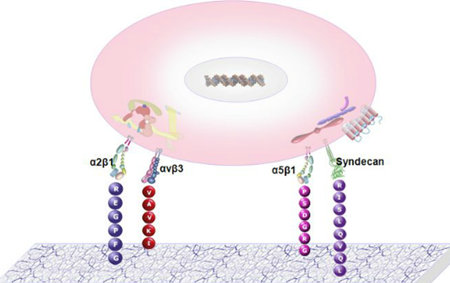Home > News > AMSBIO: Extracellular Matrix Combinatorial Library Launched
AMSBIO: Extracellular Matrix Combinatorial Library Launched
AMSBIO is a leading supplier of innovative tools for growing cells in a physiologically relevant manner. A unique Extracellular Matrix (ECM) Mimetic Library for engineering surfaces to direct receptor binding specificity, signalling and growing cells in 3D has been launched.
Containing nearly 300 biomimetics of Fibronectin, Vitronectin, Laminin and Collagen, for coating plates or creating 3D culture scaffolds, AMSBIO's new ECM combinatorial library provides a powerful tool for identifying the cellular adhesion profile of your cell line or tumour against the widest commercially available collection of cell surface receptor binding peptide motifs.
Containing nearly 300 biomimetics of Fibronectin, Vitronectin, Laminin and Collagen, for coating plates or creating 3D culture scaffolds, AMSBIO's new ECM combinatorial library provides a powerful tool for identifying the cellular adhesion profile of your cell line or tumour against the widest commercially available collection of cell surface receptor binding peptide motifs.
The extracellular microenvironment, defined by biochemical and physical cues, is a deciding factor in a wide range of cellular processes not confined solely to oncology. These include cell adhesion, proliferation, differentiation, and expression of phenotype-specific functions. Being able to engineer the ECM microenvironment provides clear benefits in studies of cell and tissue engineering and related applications. Currently existing technology offers simple (and merely adequate) environments that facilitate basic cell processes such as adhesion. The simple presentation of motifs involved in cell adhesion is not optimal for controlling more integrated processes. Crosstalk among signalling pathways acts synergistically to enhance cellular responses such as cell adhesion and/or proliferation.
A recent study showed that a combination of extracellular matrix derived peptides presented on a surface may enhance cell adhesion strength and focal adhesion assembly. This combinatorial presentation of ECM peptides on cell growth surfaces may also promote elevated proliferation rates of primary or stem cells.
Based upon the AMSBIO ECM combinatorial library, the ready to-use MAPTrix™ Array provides a means to regulate a variety of cell surface receptors for your cell studies. The basic layout of the MAPTrix™ Array is comprised of avß3 and its complementary integrins such as a2ß1 (collagen), a3ß1 (laminin), a5ß1 (fibronectin), and heparin binding motif.
To learn more preparing a biochemically defined ECM microenvironment and the ECM combinatorial library, please visit www.amsbio.com/downloads/MAPTrix/MAPTrixECMLibrary.pdf or contact AMSBIO on +44-1235-828200 / info@amsbio.com.
Founded in 1987, AMS Biotechnology (AMSBIO) is recognised as a leading international provider of unique, innovative products & custom services for life sciences research. The AMSBIO range includes over 23,000 polyclonal & monoclonal antibodies, peptides, recombinant proteins, extracellular matrix, molecular detection reagents, & tissue DNA, RNA, protein & microarray products. Key research areas include: apoptosis, cell invasion & migration, cell signaling, DNA damage, 3D culture, electrophoresis, glycobiology, post-translational modification & stem cell biology.
A recent study showed that a combination of extracellular matrix derived peptides presented on a surface may enhance cell adhesion strength and focal adhesion assembly. This combinatorial presentation of ECM peptides on cell growth surfaces may also promote elevated proliferation rates of primary or stem cells.
Based upon the AMSBIO ECM combinatorial library, the ready to-use MAPTrix™ Array provides a means to regulate a variety of cell surface receptors for your cell studies. The basic layout of the MAPTrix™ Array is comprised of avß3 and its complementary integrins such as a2ß1 (collagen), a3ß1 (laminin), a5ß1 (fibronectin), and heparin binding motif.
To learn more preparing a biochemically defined ECM microenvironment and the ECM combinatorial library, please visit www.amsbio.com/downloads/MAPTrix/MAPTrixECMLibrary.pdf or contact AMSBIO on +44-1235-828200 / info@amsbio.com.
Founded in 1987, AMS Biotechnology (AMSBIO) is recognised as a leading international provider of unique, innovative products & custom services for life sciences research. The AMSBIO range includes over 23,000 polyclonal & monoclonal antibodies, peptides, recombinant proteins, extracellular matrix, molecular detection reagents, & tissue DNA, RNA, protein & microarray products. Key research areas include: apoptosis, cell invasion & migration, cell signaling, DNA damage, 3D culture, electrophoresis, glycobiology, post-translational modification & stem cell biology.
---------------------
Worldwide HQ
AMS Biotechnology (AMSBIO)
184 Milton Park
Abingdon
Abingdon
Oxon OX14 4SE
North American HQ
AMSBIO LLC
23591 El Toro Road, Suite#180
Lake Forest, CA 92630
USA
Tel: +1-800-987-0985
Email: info@amsbio.com
Related News
- Cold Chain Technologies Expands Industry-Leading Reusable Portfolio 12/11/2025
- Sabin Vaccine Institute’s Investigational Marburg Vaccine Delivered to Ethiopia 12/9/2025
- Cutting-edge Product for Stem Cell Research and Human Embryo Modelling 12/4/2025
- Thermo Fisher Scientific Launches Industry-First, Multi-Parameter Molecular Assa 11/20/2025
- Biotech Fluidics: Solvent Recyclers Improve HPLC System Sustainability 11/20/2025
- Titan Enterprises’ Beverage Flow Meters: Turbine vs. Ultrasonic – Which is Right 11/19/2025
- Gentle and Rapid Detachment of Even Delicate Adherent Cells 11/18/2025
- Simplifying Beam Diagnostics with a Laser Beam Reducer 11/18/2025
- Radiation Tolerant Lenses for Nuclear Monitoring Systems 11/14/2025
- SI Sensors: Lower Cost Custom CMOS Image Sensors 11/13/2025



